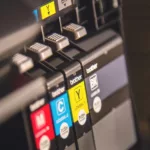These days, you must present yourself online if you want to maximize exposure for your artwork. This gives you the opportunity to connect directly with those who find your work intriguing. If you create an ecommerce website, you can have a ready portfolio of your work available to collectors 24/7/365. They can also buy it right there if the impulse strikes.
Three of the best platforms for this are Etsy, Redbubble and Shopify.
Etsy, with its homespun feel, started out as a destination for crafts. However, it has recently emerged as a viable alternative for artists seeking to monetize their work. With low commissions, very affordable listing fees and lots of traffic, Etsy offers considerable reach at a relatively low cost. On the other hand, you’ll handle all of the manufacturing and shipping yourself, plus you’ll be one of literally thousands of artists represented there. Because all are represented in exactly the same fashion, it’s easy to get lost in the clutter.
Redbubble does all of the manufacturing, shipping and accounting, so artists can concentrate on producing. In exchange for all of that service, Redbubble takes a larger slice of the pie. However, Redbubble also offers a wide variety of product options including greeting cards, smartphone and tablet cases, mugs, pillows, scarves — basically, if it’ll display an image, Redbubble will print on it. However, if you’re looking to elevate your art beyond a commodity, Redbubble could potentially trivialize your work.
Shopify costs less per transaction and offers you a standalone presence. The platform is basically training wheels to create an ecommerce website, while giving you enough control over the look of your site to tailor it specifically to your requirements. There are also applications you can leverage to implement social media promotions, targeted email campaigns and customer rewards. Additionally, Shopify allows you to accept your payments directly or through third-party gateways. Basically, if you want a customized online gallery, Shopify can make it happen. However, in exchange for all of this control, you’ll market your work yourself.
With that said, regardless of the method you choose to create an ecommerce website; you’ll have to promote it in social media. Here though, you must be strategic in your approach. Strive to connect on a human level. Yes, it’s OK to promote openings and specials from time to time, but if you do it too much people will tune you out. Instead of going for direct sales, use social media to offer insights to your process. Think of it as inviting collectors into your studio to see what your work is really about—then point them to your site. In other words, use social media to build the following you’ll monetize at your ecommerce site.
Of course, whatever platform you use, make sure your work is protected.
Always get a clear understanding of how you will be paid and at what intervals. Review commission structures to ensure you’re adequately compensated. Look for hidden licensing agreements in contracts and pay attention to shipping and handling fees.
If you use a platform on a trial basis and aren’t happy with it, cancel within the allotted time period to circumvent automated payments. Avoid upfront fees for high-resolution scans, as these only come into play when a piece sells. Study return policies carefully to make sure you aren’t blindsided by the refund of a very expensive piece. And, most importantly of all, get everything in writing.








